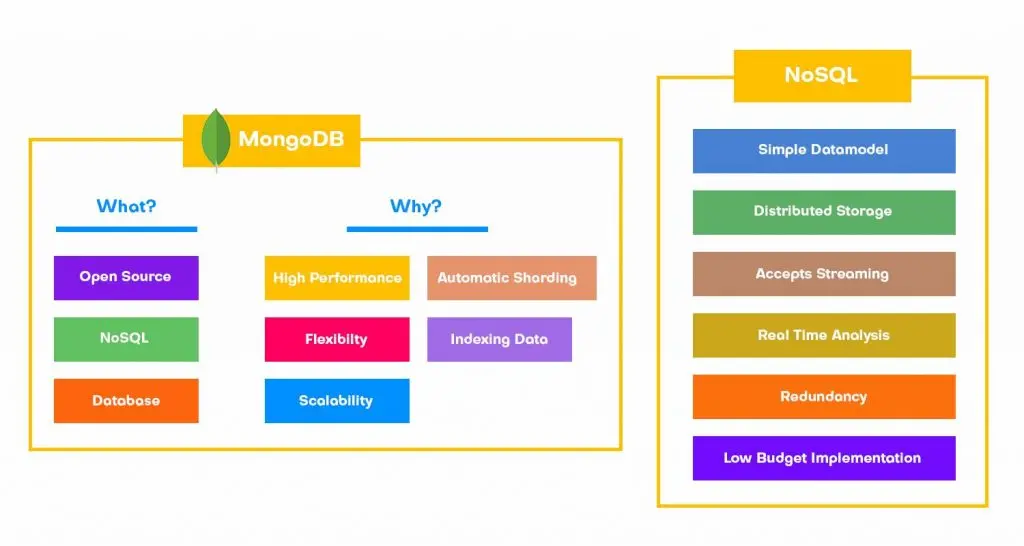In this tutorial, we are going to discuss what is MongoDB? Basic Concept of MongoDB and MongoDB is a NoSQL Database.
So let’s, first of all, discuss What is MongoDB?
MongoDB is one of the several database types to arrive in the mid2000 under the NoSQL banner. Instead of using tables containing columns and rows as seen in Relational Databases, MongoDB is built on an architecture of a collection of documents.
MongoDB is basically an Open Source NoSQL document database that provides high performance, high availability and automatic scaling.
Let’s try to understand each of these characteristics of MongoDB
By High Performance, it means that MongoDB provides the embedding which makes reads and writes faster. Indexes can include keys from embedded documents and even optional streaming rights with no acknowledgments stands out as a great feature.
Next characteristic which is High Availability, it means that replicated servers that will help to provide higher availability. With automatic sharding distributes a collection of data across machines and eventually consistently can be distributed over replicated servers.
Let’s see Why do we use MongoDB?
We use MongoDB, because of the various features which it provides. These features are as follows:
- Flexibility: – Flexibility means that you can add any type of data into the database.
So, the data in MongoDB has flexible schema collections do not enforce document structure. This flexibility gives you data modeling choices to match your application and its performance requirements. Therefore you can dynamically modify the schema without downtime and you spend less time in preparing your data for the database and more time putting your data to work.
That’s about a feature i.e. Flexibility with which you can add any type of data whether its pdf, audio, video or data compassionate working into your database.
- Scalability:- Scalability simply means that you are basically meeting the demands of data growth and scalability is the ability of a system, network or process to handle a growing amount of work in a capable manner.
Now, as the size of the data increases, a single machine may not be sufficient to store the data nor provide an acceptable read and write throughput. Sharding solves the problem with horizontal scaling. Therefore MongoDB provides you with horizontal scalability through sharding.
- High Performance: – Let’s explain this feature with the help of SQL:
MongoDB performs better in terms of queries per second from SQL. As the number of queries increases, SQL takes a longer time to process those queries as compared to MongoDB. There are various factors behind this High performance of MongoDB, which are as follows:
- MongoDB provides embedding of documents and it avoids the concept of joins and it even provides the indexing of data.
- Also, MongoDB is 2 to 10 times faster than MySQL and 50 times faster than CouchDB.
Now we have come to know that MongoDB is a NoSQL database.
As we know that MongoDB is a type of document store NoSQL database. so
MongoDB is basically an Open-Source document database and the leading NoSQL database and MongoDB avoids the traditional table-based Relational Database structure in favor of JSON-like documents with dynamic schemas, making the integration of data in certain types of applications easier and faster.
There are various reasons to Why do we use NoSQL? Few of these reasons are as follows:
- NoSQL provides a simpler data model. This means that you do not have to use the concepts like joins rather it encourages the concepts of embedding your data and indexing your data.
- It helps the developers in the rapid development of their applications.
- If scalability is considered then it provides high scalability i.e. high scaling out capability.
- It even provides high flexibility means you can add any type of data into your database.
- It also helps you in providing distributed storage i.e. your data can be present on multiple servers which will basically help you to provide the high availability of your data.
- It even accepts the streaming i.e. high volume of data which can be stored in your database.
- It helps you to provide the real-time analysis.
- It gives you the capability of redundancy or reliability i.e. to make your data highly available by replicating your data on multiple servers.
- It does not need to be implemented on a very high budget due to its high scalability you can implement it on a very low budget.


You must log in to post a comment.